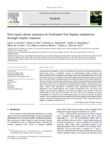Please use this identifier to cite or link to this item:
http://www.alice.cnptia.embrapa.br/alice/handle/doc/901961| Title: | First report about saxitoxins in freshwater fish Hoplias malabaricus through trophic exposure. |
| Authors: | SILVA, C. A. da  OBA, E. T.   RAMSDORF, W. A.   MAGALHÃES, V. F.   CESTARI, M. M.   RIBEIRO, C. A. O.   ASSIS, H. C. S. de   |
| Affiliation: | ELIANE TIE OBA YOSHIOKA, CPAF-AP. |
| Date Issued: | 2011 |
| Citation: | Toxicon, Oxford, v. 57, n. 1, p. 141-147, jan. 2011. |
| Description: | Cyanobacterial waterblooms, such as the saxitoxin (STX) producer Cylindrospermopsis raciborskii, have been a worldwide concern in environmental health. However, the bioaccumulation of this neurotoxin in the trophic chain is not completely known. The aim of the present work was to evaluate STX bioaccumulation through chemical analyses and the toxic and trophic effects using biomarkers in the tropical freshwater fish Hoplias malabaricus. They were fed once every five days with Astyanax sp. before being subjected to intraperitoneal inoculation with STX extract (0.08 mg/100 g) obtained by lysis of toxic C. raciborskii strain (T3). After 20 days the brain was collected for acetylcholinesterase (AChE), superoxide dismutase (SOD), catalase (CAT), glutathione S-transferase (GST), glutathione peroxidase (GPx), glutathione (GSH), lipoperoxidation (LPO), protein carbonylation (PCO), and comet assay analysis. The muscle was collected for STX chemical analysis. The activities of SOD and concentrations of PCO and LPO increased. The CAT, GST, and GPx activities decreased. Genotoxicity was observed in the experimental group. STX was not detected in muscle samples. Thus, an oxidative stress was observed in the brain, leading to the damage of lipids, proteins, and DNA. The mechanism of action of the neurotoxin in this subchronic exposure suggests an apoptotic cellular process. |
| Thesagro: | Peixe de água doce Traíra Toxina |
| Type of Material: | Artigo de periódico |
| Access: | openAccess |
| Appears in Collections: | Artigo em periódico indexado (CPAF-AP)  |
Files in This Item:
| File | Description | Size | Format | |
|---|---|---|---|---|
| AP2011Firstreport.pdf | 515,31 kB | Adobe PDF |  View/Open |









